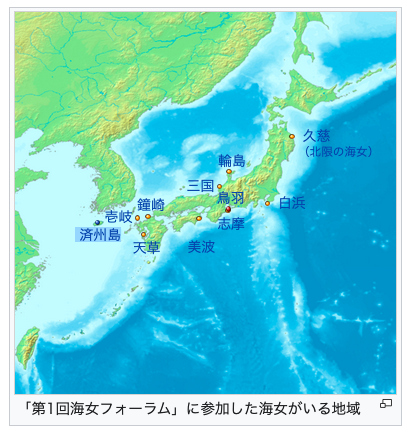The Ama part 4
Japan's Professional freedivers
A Kuroshio-area freediving culture
It is important to keep in mind ama type divers, while commonly associated with Japan, are historically not an exclusively Japanese development.
Though they are not really encountered on the mainland today, there are ancient Chinese accounts describing similar diving professionals on the continental coast.
Image source: Wikimedia
Chinese pearl-diving, in Song Yingxing’s 1637 Tiangong Kaiwu encyclopedia of technology
More importantly, the Korean island of Jeju has, to this day, a very similar tradition of female freedivers, organised in a similar hierarchical structure, with similar religious practices and similar diving techniques, including the technique of whistling while recovering on the surface to speed up CO2 venting and O2 intake (called isobue in Japanese and sumbisori in Korean), and is a form of recovery breathing.
The Korean professional freedivers of Jeju are called haenyeo (written with the same sinogram combination reading “sea woman” [海女], as their Japanese counterparts).
Haenyeo women were involved against the Japanese during the colonial period, and have become a symbol of national pride in Korea, and seeking to highlight differences unfortunately does not help bridge research on these two obviously connected in the case of these two traditional diving cultures.
There was even was a form of competition between Korea and Japan when it came to registering this cultural asset with the UN, as illustrated by this article for instance.
Here are some examples:
It seems very likely that ama–haenyeo-like freediving professional are neither an exclusively Japanese nor Korean developments, but rather a regional culture, shaped by conditions induced by the Kuroshio warm current.
While surviving traditions are found almost exclusively in Japan and Korea, historically breath-hold sea activities existed in different areas of the Kuroshio zone, including the islands of Japan and the Ryū-Kyū arc, along with different areas along continental coasts and the Korean Peninsula.
In Japan, ama divers are now mostly concentrated on the Pacific-coast of western Honshū, but were historically been active from Tōhoku’s Pacific coast to Okinawa, with strongest concentration of their activities being on the sea of Japan, and Central Japan and Kansai to Kyūshū.

Image source: bunka.nii.ac.jp/heritages

Image source: www.furusato-tax.jp
Ama culture, past and present
Amas dived primarily to collect seafood (especially shells), seaweed, and, later, cultivated pearls.
After cultured pearls and pearl farming techniques were developed in Kansai in the late 19th century, along with the establishment of large aquaculture farms in western Japan, such as Toba’s Mikomoto Pearl Island, pearl collection became one of their primary activity, and actually increased the demand for ama-type divers, that were also recruited in Korea during the colonial period.
Pearl cultivation requires introducing an irritant into the oyster, and then placing the oyster in a safe place and checking in on it, before finally harvesting, operations in which ama breath-hold divers were the most useful workforce, though hard-hat divers were also used.
The specificities of pearl culture also led to the development of the lightweight Ohgushi Respirator unit, which could be used tethered or self-contained.
In the 1940s, roughly 6000 amas were reported to be active along the coasts of Japan whereas today amas are estimated at less than 70 divers per generation, and are increasingly turning into a tourist attraction.
However, the divers still have practical use for regulated seafood collection activities, to maintain sustainable fisheries.

Image source: jokuti.blog.hu
The amas traditionally formed a close-knit society, sharing communal drying out timesin work-huts (amagoya), and had their own codes and religious rituals.
However the recent development of ama tourism, while trying to maintain ama local traditions and present them to the outside world, is also introducing many changes to what is left of these women’s traditional practices, as is usually the case when a cultural tradition evolves into a folklore.
The centre of ama tourism is Kansai’s Mie prefecture, especially the Ise-shima peninsula area, which features attractions such as the Mikimoto pearl island and museum, the Toba Sea Folk Museum, and more.
It is also possible to book and ama hut experience, to taste fresh local charcoaled-grilled seafood and get meet the divers in between dives, and even get wet and freedive with ama divers.
Modern freediver Emily Corinne Tucker went to dive with amas in Mie Prefecture in 2015, this is her report on the Deeperblue.com forum
Image source: miescape.jp

Image source: www.jldb.bunka.go.jp
To conclude on a rather interesting anecdote, freediver Jacques Mayol, who single-handedly invented the modern approach to freediving, and of The Big Blue movie fame, was born in Shanghai, where he grew up (and not in Greece like in the movie).
As a child, Mayol spent all his summer holidays in Japan, in Kyūshū’s Karatsu area (Saga prefecture), which was easily reached using the Shanghai-Nagasaki ocean line.
It is there he first learned to skin dive with his brother, when he was 6/7 years old (1933), and recalls being fascinated by ama freedivers collecting shells in the area.
Dolphins played an important role in his life, and Jacques also saw his first dolphin near the Nanatsugama caves in Karatsu.
In inspiring a young Jacques Mayol to explore the underwater world, Japan’s traditional ama divers might have, in an indirect way, contributed to the birth of modern freediving…

Image source: www.arcgis.com
[More info on ama divers here ]







